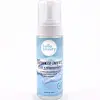What's inside
What's inside
 Key Ingredients
Key Ingredients

 Benefits
Benefits

 Concerns
Concerns

 Ingredients Side-by-side
Ingredients Side-by-side

Water
Skin ConditioningSodium Cocoamphoacetate
CleansingSodium Cocoyl Apple Amino Acids
Skin ConditioningHydroxyethyl Urea
HumectantSodium Lauroyl Sarcosinate
CleansingLaureth-7 Citrate
CleansingDecyl Glucoside
CleansingSodium PCA
HumectantSodium Cocoyl Glutamate
CleansingMaltooligosyl Glucoside
Skin ConditioningHydrogenated Starch Hydrolysate
HumectantSodium Hyaluronate
HumectantParfum
MaskingCitric Acid
BufferingChlorphenesin
AntimicrobialMagnesium Nitrate
Methylchloroisothiazolinone
PreservativeMethylisothiazolinone
PreservativeMagnesium Chloride
Sodium Phytate
Water, Sodium Cocoamphoacetate, Sodium Cocoyl Apple Amino Acids, Hydroxyethyl Urea, Sodium Lauroyl Sarcosinate, Laureth-7 Citrate, Decyl Glucoside, Sodium PCA, Sodium Cocoyl Glutamate, Maltooligosyl Glucoside, Hydrogenated Starch Hydrolysate, Sodium Hyaluronate, Parfum, Citric Acid, Chlorphenesin, Magnesium Nitrate, Methylchloroisothiazolinone, Methylisothiazolinone, Magnesium Chloride, Sodium Phytate
Water
Skin ConditioningSodium Cocoyl Glutamate
CleansingDisodium Cocoyl Glutamate
CleansingGlycerin
HumectantCocamidopropyl Betaine
CleansingSodium Cocoyl Apple Amino Acids
Skin ConditioningHydroxyethyl Urea
HumectantNiacinamide
SmoothingMaltooligosyl Glucoside
Skin ConditioningHydrogenated Starch Hydrolysate
HumectantAlmond Oil Glycereth-8 Esters
EmollientPhenoxyethanol
PreservativeEthylhexylglycerin
Skin ConditioningParfum
MaskingSodium Hyaluronate
HumectantTrisodium Ethylenediamine Disuccinate
Hexyl Cinnamal
PerfumingWater, Sodium Cocoyl Glutamate, Disodium Cocoyl Glutamate, Glycerin, Cocamidopropyl Betaine, Sodium Cocoyl Apple Amino Acids, Hydroxyethyl Urea, Niacinamide, Maltooligosyl Glucoside, Hydrogenated Starch Hydrolysate, Almond Oil Glycereth-8 Esters, Phenoxyethanol, Ethylhexylglycerin, Parfum, Sodium Hyaluronate, Trisodium Ethylenediamine Disuccinate, Hexyl Cinnamal
Ingredients Explained
These ingredients are found in both products.
Ingredients higher up in an ingredient list are typically present in a larger amount.
We don't have a description for Hydrogenated Starch Hydrolysate yet.
We don't have a description for Maltooligosyl Glucoside yet.
Parfum is a catch-all term for an ingredient or more that is used to give a scent to products.
Also called "fragrance", this ingredient can be a blend of hundreds of chemicals or plant oils. This means every product with "fragrance" or "parfum" in the ingredients list is a different mixture.
For instance, Habanolide is a proprietary trade name for a specific aroma chemical. When used as a fragrance ingredient in cosmetics, most aroma chemicals fall under the broad labeling category of “FRAGRANCE” or “PARFUM” according to EU and US regulations.
The term 'parfum' or 'fragrance' is not regulated in many countries. In many cases, it is up to the brand to define this term.
For instance, many brands choose to label themselves as "fragrance-free" because they are not using synthetic fragrances. However, their products may still contain ingredients such as essential oils that are considered a fragrance by INCI standards.
One example is Calendula flower extract. Calendula is an essential oil that still imparts a scent or 'fragrance'.
Depending on the blend, the ingredients in the mixture can cause allergies and sensitivities on the skin. Some ingredients that are known EU allergens include linalool and citronellol.
Parfum can also be used to mask or cover an unpleasant scent.
The bottom line is: not all fragrances/parfum/ingredients are created equally. If you are worried about fragrances, we recommend taking a closer look at an ingredient. And of course, we always recommend speaking with a professional.
Learn more about ParfumWe don't have a description for Sodium Cocoyl Apple Amino Acids yet.
Sodium Cocoyl Glutamate is a gentle cleanser and surfactant. It is the sodium salt of the Cocoyl Glutamic Acid and comes from coconut oil. As a surfactant, it helps lift dirt and oil to be washed away.
Sodium Cocoyl Glutamate also has an emolliating effect and can help leave the skin feeling soft.
Sodium Hyaluronate is hyaluronic acid's salt form. It is commonly derived from the sodium salt of hyaluronic acid.
Like hyaluronic acid, it is great at holding water and acts as a humectant. This makes it a great skin hydrating ingredient.
Sodium Hyaluronate is naturally occurring in our bodies and is mostly found in eye fluid and joints.
These are some other common types of Hyaluronic Acid:
Learn more about Sodium HyaluronateWater. It's the most common cosmetic ingredient of all. You'll usually see it at the top of ingredient lists, meaning that it makes up the largest part of the product.
So why is it so popular? Water most often acts as a solvent - this means that it helps dissolve other ingredients into the formulation.
You'll also recognize water as that liquid we all need to stay alive. If you see this, drink a glass of water. Stay hydrated!
Learn more about Water